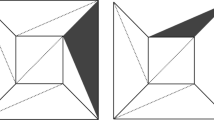Abstract
This paper shows how a new approach to theorem proving by analogy is applicable to real maths problems. This approach works at the level of proof-plans and employs reformulation that goes beyond symbol mapping. The Heine-Borel theorem is a widely known result in mathematics. It is usually stated in R1 and similar versions are also true in R2, in topology, and metric spaces. Its analogical transfer was proposed as a challenge example and could not be solved by previous approaches to theorem proving by analogy. We use a proof-plan of the Heine-Borel theorem in R1 as a guide in automatically producing a proof-plan of the Heine-Borel theorem in R2 by analogy-driven proof-plan construction.
This work was supported in part by the HC&M grant CHBICT930806 and by a research grant of the Deutsche Forschungsgemeinschaft.
On leave from University Saarbrücken, Germany
Preview
Unable to display preview. Download preview PDF.
Similar content being viewed by others
References
W.W. Bledsoe. The use of analogy in automatic proof discovery. Tech.Rep. AI-158-86, Microelectronics and Computer Technology Corporation, Austin, TX, 1986.
W.W. Bledsoe. Heine-Borel theorem analogy example. Technical Report Memo ATP 124, University of Texas Computer Science Dept, Austin, TX, August 1994.
A. Bundy. The use of explicit plans to guide inductive proofs. In E. Lusk and R. Overbeek, editors, Proc. 9th International Conference on Automated Deduction (CADE), volume 310 of Lecture Notes in Computer Science, pages 111–120, Argonne, 1988. Springer.
J.G. Carbonell. Derivational analogy: A theory of reconstructive problem solving and expertise acquisition. In R.S. Michalsky, J.G. Carbonell, and T.M. Mitchell, editors, Machine Learning: An Artificial Intelligence Approach, pages 371–392. Morgan Kaufmann Publ., Los Altos, 1986.
P. Deussen. Halbgruppen und Automaten, volume 99 of Heidelberger Taschenbücher. Springer, 1971.
X. Huang, M. Kerber, M. Kohlhase, E. Melis, D. Nesmith, J. Richts, and J. Siekmann. Omega-MKRP: A Proof Development Environment. In Proc. 12th International Conference on Automated Deduction (CADE), Nancy, 1994.
X. Huang, M. Kerber, M. Kohlhase, and J. Richts. Methods — the basic units for planning and verifying proofs. In Proceedings of Jahrestagung für Künstliche Intelligenz, Saarbrücken, 1994. Springer.
Th. Kolbe and Ch. Walther. Patching proofs for reuse. In N. Lavrac and S. Wrobel, editors, Proceedings of the 8th European Conference on Machine Learning 1995, Kreta, 1995.
P. Madden. Automated Program Transformation Through Proof Transformation. PhD thesis, University of Edinburgh, 1991.
W.W. McCune. Otter 2.0 users guide. Technical Report ANL-90/9, Argonne National Laboratory, Maths and CS Division, Argonne, Illinois, 1990.
E. Melis. Change of representation in theorem proving by analogy. SEKI-Report SR-93-07, Universität des Saarlandes, Saarbrücken, 1993.
E. Melis. How mathematicians prove theorems. In Proceedings of the Sixteenth Annual Conference of the Cognitive Science Society, pages 624–628, Atlanta, Georgia U.S.A., 1994.
E. Melis. Analogy-driven proof-plan construction. Technical Report DAI Research Paper No 735, University of Edinburgh, AI Dept, Dept. of Artificial Intelligence, Edinburgh, 1995.
E. Melis. A model of analogy-driven proof-plan construction. In Proceedings of the International Conference on Artificial Intelligence, Toronto, 1995. Morgan Kaufmann.
E. Melis and M.M. Veloso. Analogy makes proofs feasible. In D. Aha, editor, AAAI-94 Workshop on Case Based Reasoning, pages 13–17, Seattle, 1994.
G. Polya. How to Solve it. 2nd ed. Doubleday, New York, 1957.
S.J. Russell. Analogy by similarity. In D. Helman, editor, Analogical Reasoning, pages 251–269. Kluwer Academic Publisher, 1988.
B.L. van der Waerden. Wie der Beweis der Vermutung von Baudet gefunden wurde. Abh.Math.Sem. Univ.Hamburg, 28, 1964.
M.M. Veloso. Flexible strategy learning: Analogical replay of problem solving episodes. In Proc. of the twelfth National Conference on Artificial Intelligence 1994, Seattle, WA, 1994.
L. Wos. Automated Reasoning: 33 Basic Research Problems. Prentice-Hall, Englewood Cliffs, 1988.
Author information
Authors and Affiliations
Editor information
Rights and permissions
Copyright information
© 1995 Springer-Verlag Berlin Heidelberg
About this paper
Cite this paper
Melis, E. (1995). Theorem proving by analogy — A compelling example. In: Pinto-Ferreira, C., Mamede, N.J. (eds) Progress in Artificial Intelligence. EPIA 1995. Lecture Notes in Computer Science, vol 990. Springer, Berlin, Heidelberg. https://doi.org/10.1007/3-540-60428-6_22
Download citation
DOI: https://doi.org/10.1007/3-540-60428-6_22
Published:
Publisher Name: Springer, Berlin, Heidelberg
Print ISBN: 978-3-540-60428-0
Online ISBN: 978-3-540-45595-0
eBook Packages: Springer Book Archive




